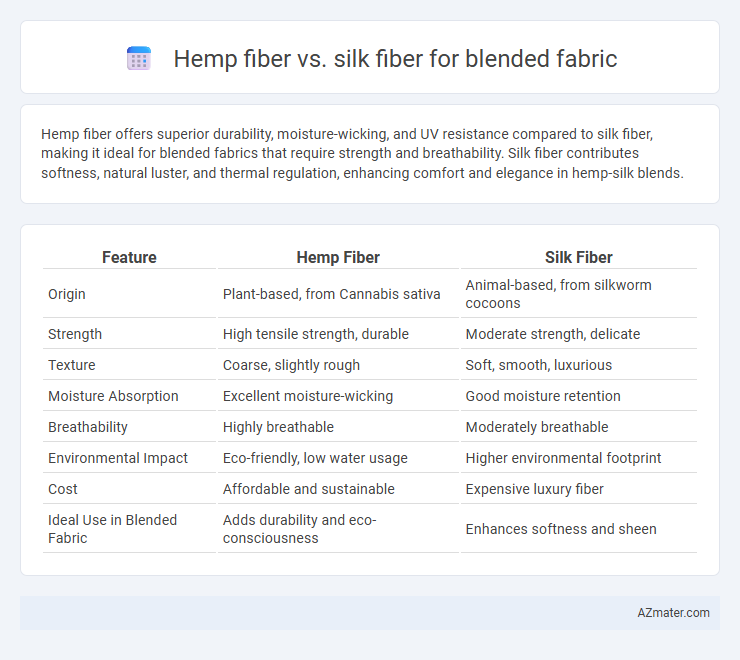Hemp fiber offers superior durability, moisture-wicking, and UV resistance compared to silk fiber, making it ideal for blended fabrics that require strength and breathability. Silk fiber contributes softness, natural luster, and thermal regulation, enhancing comfort and elegance in hemp-silk blends.
Table of Comparison
| Feature | Hemp Fiber | Silk Fiber |
|---|---|---|
| Origin | Plant-based, from Cannabis sativa | Animal-based, from silkworm cocoons |
| Strength | High tensile strength, durable | Moderate strength, delicate |
| Texture | Coarse, slightly rough | Soft, smooth, luxurious |
| Moisture Absorption | Excellent moisture-wicking | Good moisture retention |
| Breathability | Highly breathable | Moderately breathable |
| Environmental Impact | Eco-friendly, low water usage | Higher environmental footprint |
| Cost | Affordable and sustainable | Expensive luxury fiber |
| Ideal Use in Blended Fabric | Adds durability and eco-consciousness | Enhances softness and sheen |
Introduction to Hemp and Silk Fibers
Hemp fiber, derived from the Cannabis sativa plant, is known for its exceptional strength, durability, and eco-friendly properties, making it a sustainable choice for blended fabrics. Silk fiber, produced from the cocoons of the Bombyx mori silkworm, offers luxurious softness, natural sheen, and excellent breathability. Blending hemp with silk combines the robustness and sustainability of hemp with the smooth texture and elegance of silk, creating a fabric that balances performance and comfort.
Historical Context of Hemp and Silk Usage
Hemp fiber has been used for over 10,000 years, historically valued for its durability and resistance to pests, making it a staple in ancient textiles and ropes across Asia and Europe. Silk production dates back to ancient China around 2700 BCE, prized for its luxurious texture and strength, often symbolizing wealth and status in historical trade routes such as the Silk Road. Blended fabrics combining hemp and silk leverage hemp's rugged longevity with silk's smooth elegance, reflecting centuries of textile innovation that balance functionality and luxury.
Sustainability: Hemp vs Silk Environmental Impact
Hemp fiber offers superior sustainability compared to silk fiber due to its low water usage, rapid growth cycle, and minimal pesticide requirement, significantly reducing environmental impact. Silk production involves intensive resource consumption, including large quantities of water and feed for silkworms, alongside ethical concerns regarding animal welfare. Blended fabrics incorporating hemp can reduce carbon footprint and promote eco-friendly textile manufacturing while maintaining strength and texture.
Fiber Properties: Strength, Fineness, and Durability
Hemp fiber exhibits superior strength and durability compared to silk fiber, making it ideal for blended fabrics requiring long-lasting wear and resistance to abrasion. While hemp fibers are coarser with a higher tensile strength, silk fibers are finer and provide a smooth, luxurious texture, enhancing the blend's overall softness and drape. The combination of hemp's robust durability with silk's fineness results in blended fabrics that balance resilience with refined aesthetics.
Blending Techniques: Methods and Best Practices
Blending hemp fiber with silk in fabric production utilizes techniques such as carding, combing, and air-jet spinning to ensure uniform fiber distribution and enhanced fabric strength. Optimal fiber length alignment and moisture control during blending improve the smoothness and durability of the resulting blended fabric. Best practices emphasize precise ratio adjustments and thorough cleaning of hemp fibers to maintain the delicate texture and sheen characteristic of silk.
Comfort and Breathability in Blended Fabrics
Hemp fiber in blended fabrics offers superior breathability and moisture-wicking properties compared to silk fiber, making it ideal for comfortable, cool wear in warm climates. Silk fiber, while providing a smooth and luxurious texture, enhances thermal regulation but may retain more moisture, reducing overall breathability. Blending hemp and silk combines the durability and eco-friendliness of hemp with the softness and natural sheen of silk, resulting in fabrics that balance comfort and airflow efficiently.
Dyeing and Finishing Compatibility
Hemp fiber exhibits high dye absorption due to its natural lignin content, providing vibrant and long-lasting colors in blended fabrics, while silk fiber offers excellent dye affinity resulting in rich and lustrous hues. In blended fabrics, hemp's coarse texture requires specialized finishing techniques to enhance softness, whereas silk's smooth surface facilitates a luxurious finish and sheen. Compatibility in dyeing and finishing processes ensures that blended fabrics maintain colorfastness and durability without compromising the tactile qualities of either fiber.
Cost Comparison: Raw Material and Processing
Hemp fiber offers a cost-effective alternative to silk fiber in blended fabrics due to its lower raw material price and reduced processing expenses. Silk production involves labor-intensive sericulture and complex extraction methods, driving up costs, while hemp benefits from eco-friendly, scalable cultivation and simpler fiber extraction processes. The combined cost advantage of hemp reduces overall fabric production expenses, making hemp-silk blends more affordable without compromising durability.
End-Use Applications of Hemp-Silk Blends
Hemp-silk blended fabrics combine the durability and moisture-wicking properties of hemp with the luxurious softness and sheen of silk, making them ideal for high-end fashion apparel and sustainable activewear. These blends enhance breathability and tensile strength, suitable for eco-conscious consumers seeking comfort without sacrificing style. Applications extend to home textiles, such as bedding and upholstery, where the blend's natural antibacterial and hypoallergenic qualities provide added value.
Future Trends in Hemp and Silk Fabric Blends
Hemp fiber's durability and sustainability combined with silk's softness and luster are driving innovation in blended fabrics for eco-conscious fashion markets. Future trends indicate increased adoption of hemp-silk blends due to their biodegradability, moisture-wicking properties, and improved textile performance for luxury apparel. Advances in eco-friendly processing technologies and rising consumer demand for sustainable fabrics will further boost the prominence of hemp and silk fabric blends.

Infographic: Hemp fiber vs Silk fiber for Blended Fabric
 azmater.com
azmater.com